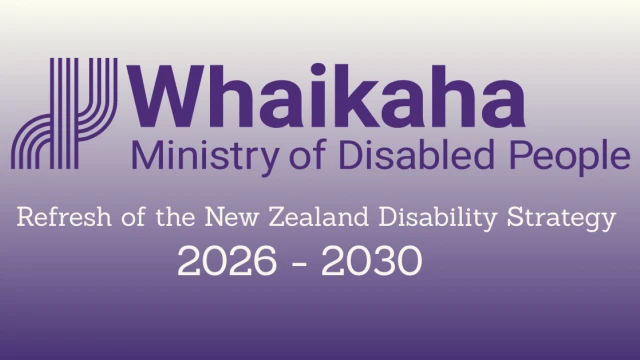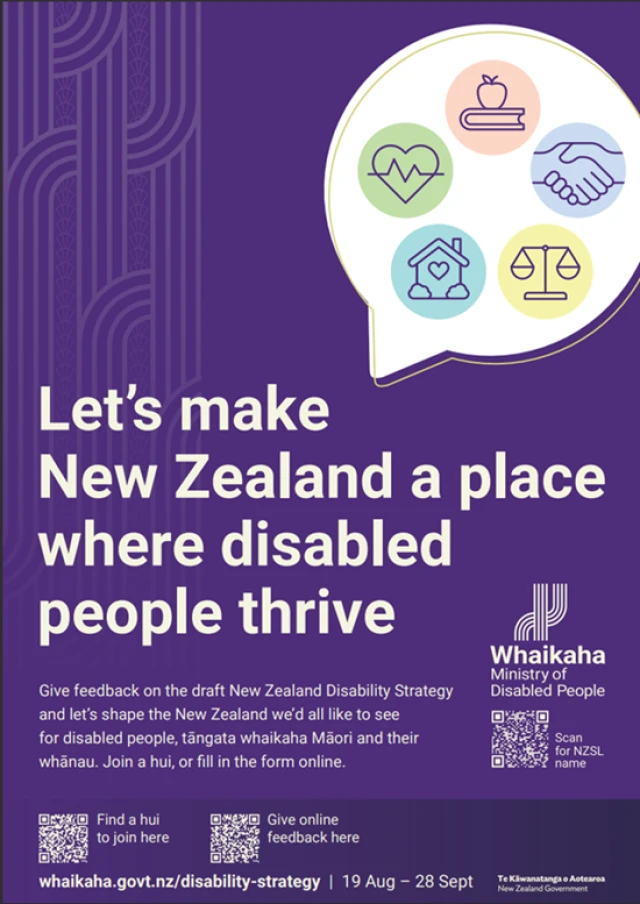New Zealand Disability Strategy open for consultation
Whaikaha – Ministry of Disabled People has released the draft New Zealand Disability Strategy for 2026 to 2030 and they want to hear what you think.
August 25th, 2025

The New Zealand Disability Strategy guides the Government and government agencies on how to make things better for disabled people in Aotearoa New Zealand.
The current strategy is for 10 years and ends next year. This new strategy will run from 2026 to 2030.
You can find the draft New Zealand Disability Strategy here on the Whaikaha website.
It is a draft, which means that if you spot some things that you think could be done better or looked at in a different way, it just might change.
Before we get into how you can have your say, let’s go over the key features of the draft strategy.
Priority outcome areas
The draft strategy has five priority outcome areas. These are key areas where the disability advisory group on the strategy have stated that there needs to be improvements made for our disability community.
Each priority outcome area has a goal and several actions that the Government needs to take to meet that goal.
The outcomes the draft stays we should aim for are:
1. Education
Disabled people will be supported to attend, participate and reach their potential in education.
2. Employment
Disabled people will have meaningful career opportunities, equal to non-disabled people, and be valued the same way. Employers will recognise disabled people’s talents and provide accessible and inclusive workplaces.
3. Health
Disabled people will achieve the highest possible standard of health and wellbeing. They will decide what this means for themselves and their whānau.
4. Housing
Disabled people and their whānau will have affordable, healthy, secure, and accessible homes that meet their needs.
5. Justice
Disabled people will have their human rights protected and be treated fairly by the justice system, taking into account inequalities they face.
What do you think? Are there any outcomes the working group might have missed or more they should include? Find out all the ways to have your say below.
What does New Zealand want the strategy to achieve?
This is the overall ‘Vision’ for the strategy.
“New Zealand is an accessible and equitable society for disabled people and their whānau – a place where disabled people thrive, lead, and participate in all aspects of life.”
The purpose of a vision like it is to guide the strategy to an ideal end result for disabled people.
What is the approach to building the strategy?
This draft strategy was built on seven key principals. Principles are the key values and ideas that determine what goes into the strategy. When people come up with ideas for outcomes and plans, they have to make sure that they are still right according to the principles below. This means if someone proposed something that wouldn’t meet human rights or promote participation and inclusion, it couldn’t be included in the strategy.
The principles
Accessibility – Accessibility is essential for all people to be able to participate and feel included in society.
Choice and control – Disabled people are the experts in their own lives and should be able to make decision about things that affect them.
Equity, cultural inclusion and intersectionality – The strategy recognises that disabled community come from a range of different communities and cultures with their own values and ways of doing things. Intersectionality is how a combination of aspects of someone’s identity, like gender, ethnicity, sexuality and ability, affects their experiences in society.
Human rights – The strategy follows international human rights frameworks set by the United Nations.
Participation and inclusion – Disabled people have the right to be active members in their communities in all aspects of life.
Respect and dignity - Everyone deserves to be treated with respect, regardless of their abilities.
Te Tiriti o Waitang | The Treaty of Waitangi - Te Tiriti establishes the relationship between Māori and the Crown, recognising the unique position of Māori as tāngata whenua (indigenous people), and ensuring partnership, participation and protection for tāngata whaikaha Māori (disabled Māori people).
How to have your say
Consultation on the New Zealand Disability Strategy 2026- 2030 is open from now until Sunday 28 September 2025.
There are plenty of ways you can give your feedback.
Online feedback form – this form has several accessibility options including larger text, Easyread, sign language, and the option for you to answer questions with voice recordings.
Fill out the feedback form.
Hui/meeting - you can attend a Zoom meeting online or an in-person meeting.
Find Zoom and in-person meeting times and register here.
Video recording – you can make a three-minute video sharing your feedback.
Make you video here and email it to disabilitystrategy@whaikaha.govt.nz
Download a feedback form. There are multiple formats available below:
Once you’ve filled in your form, email to disabilitystrategy@whaikaha.govt.nz
You can also post it free of charge to:
New Zealand Disability Strategy Consultation
Whaikaha – Ministry of Disabled People
Reply paid 262204
PO Box 1556
Wellington 6140
What’s next?
After Sunday 28 September, consultation will be closed. The feedback will then be reviewed and the draft will be updated to a final strategy. This document will then go to Cabinet for approval. Cabinet is the central decision-making body of the Government. Meetings are attended by key government ministers.
The aim is to publish the strategy in early December.’
The strategy will then be launched in December 2025.
